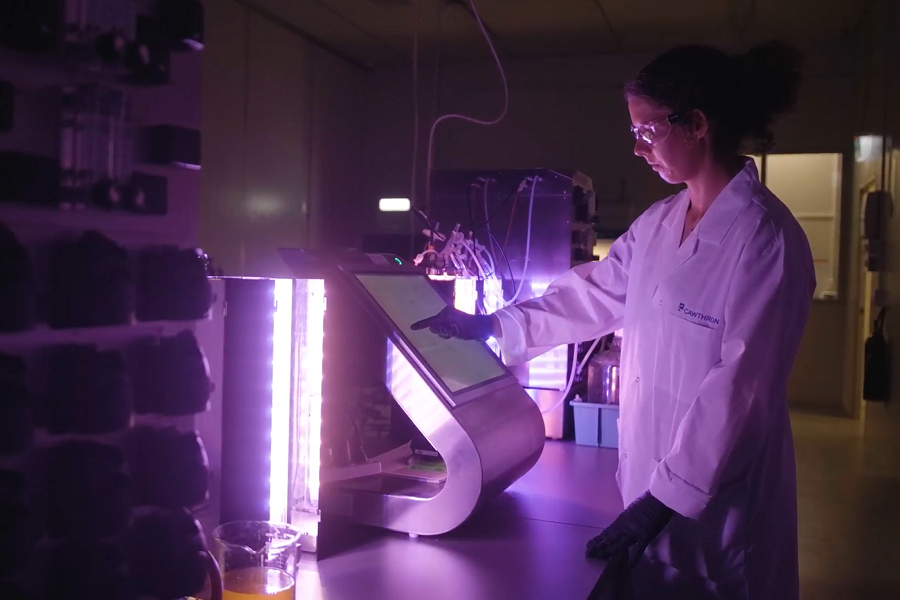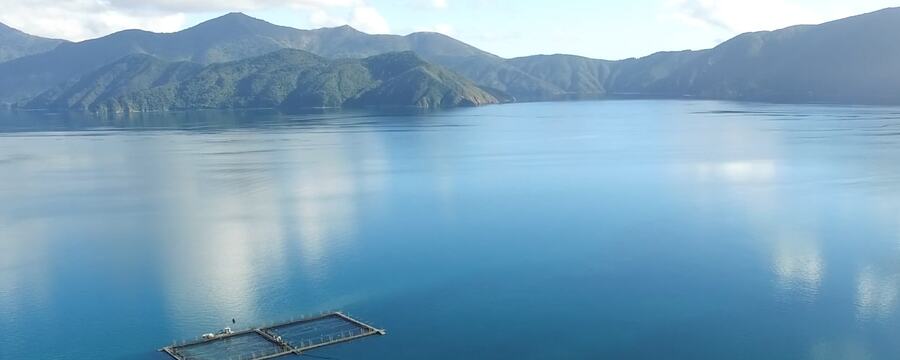Marine biotechnology

Share this step
Marine biotechnology – Definition
Biotechnology is defined as harnessing cellular and biomolecular processes to develop technologies and products that help improve our lives and the health of our planet.
Maritime biotechnology’s main activity is to adjust marine organism’s biological processes for medical, industrial and other purposes. It is also called blue biotechnology and has become an important priority for global science and research.
Marine life has adapted to thrive in the extreme ambient conditions found in the sea. Marine biotechnology is concerned with the exploration and exploitation of the resulting diverse marine organisms in order to develop new products.
Marine biotechnology – Opportunities
There are numerous applications of the use of biotechnology to improve and maintain a sustainable marine environment, from stimulating reproduction and improving growth rates of fishes in aquaculture farms to creating biofuels from microalgae – potentially contributing to solving important global societal challenges of sustainable food security, environmental sustainability, and human health.
Marine biotechnology – Global context
Marine biotechnology is a rapidly emerging sector that is still in its infancy. But barriers are inhibiting growth, such as the initial discovery process, lack of major infrastructure, limited capability to cultivate the organisms in the laboratory, and most importantly, at a commercial scale. Other barriers include underfunding, legal and regulatory issues, and restricted access to the ocean.
Marine biotechnology – New Zealand context
Given New Zealand’s location and scale of the maritime area, it is likely that there are substantial unexplored and underexploited marine resources that could be developed for biotechnology sector use.
Marine biotechnology is an emerging part of New Zealand’s biotechnology ecosystem, with 11% of biotechnology organisations working in marine biosciences.
- NZ Department of Conservation – biodiversity
New Zealand is a world hotspot for biodiversity, with over 17,000 known species and more are being discovered all the time.
Marine biotechnology – Case studies & resources
Below is a list of interviews with people who work in marine biotechnology and case studies to help expand your view of this topic. You do NOT need to read them all, however we recommend you select 3 or more of the topics that interest you, and use the provided links (or your own internet search) to investigate further:
- CH4 Global: Creating positive environmental impact for its solutions in decreasing livestock-linked methane
CH4 Global is a New Zealand startup that is developing seaweed farming systems focusing on the production of the Asparagopsis species. The Asparagopsis seaweed produces a bioactive compound called bromoform which prevents the formation of methane in the gut during the digestion in animals such as cattle - Plant & Food Research: More sustainable aquafeed
Scientists at Plant & Food Research are exploring and designing future aquafeeds and ingredients to support the sustainable growth of marine fish aquaculture in Aotearoa New Zealand. Most current ingredients have limited scope for growth due to environmental limitations, dependency on other food production systems and competition with direct human consumption. - Open Ocean Aquaculture
Designing systems that can be made mobile and highly adaptable to suit different fish species, and also survive the high energy waters that lay over the horizon. Also, breeding the right fish to survive in an aquaculture system, creating new nutritious foods and mechanisms to feed the fish, finding ways to ensure fish are healthy and monitor their performance, and how to keep structures clean. - Maximising value from our seafood resources
Cyber Physical Seafood Systems (Cyber-Marine) is a new multi-million dollar research programme aimed at achieving 100% utilisation and maximised value for all harvested wild and aquacultured seafood. Making use of all raw material will allow the industry to achieve growth targets without increasing catch volume from wild-capture fisheries as well as maximise value from increasing aquaculture. Once established for the seafood industry, the technology could be adapted for any bio-industrial process. - Exploring novel ways to utilise biofouling (living organisms that accumulate on human-made marine structures like aquaculture pens)
In collaboration with global biofouling experts Cawthron Institute, iwi and industry, the research is exploring alternative biofouling management tools, technologies and strategies - Could Aoteroa produce lab-grown seafood? (2022)
One alternative is seafood products created from lab-grown cells. Called cellular-aquaculture, this cutting-edge technology is poised to take off globally. While lab grown meat has advanced enormously since the production of the first prototype burger in 2013, these days cellular aquaculture technologies are also rapidly gaining pace. - Plant protein for aquafeed
Finding new sustainable ways to produce the raw materials for aquafeed is important for expanding aquaculture production. - Morphometric software for image analysis
Plant & Food Research’s Morphometric Software™ is a collection of software modules for image analysis currently under development, initially focussed on marine species. The goal of the software is to facilitate high-throughput phenotyping and product quality assessments for both scientific and commercial applications using imaging technology. - Aotearoa New Zealand boosted by biotech: Innovating for a Sustainable Future.
Global megatrends including climate change, overuse of natural resources, water shortages, increasing dependence on fossil fuels, population growth and related healthcare needs are impacting the entire world. These trends are dramatically impacting all economies, driving demand for technologies, including biotechnology, to help mitigate these challenges. Biotechnology specifically, has been identified as critical in finding innovative solutions to some of these global challenges. - YouTube video: Sustainable Seas National Science Challenge: Uncovering estuary health with eDNA
New research shows environmental DNA, or eDNA, can help scientists quickly detect ecosystem changes, helping us to manage our estuary health better. - YouTube video: Discovering Life Under Antarctica’s Ice
Drew Lohrer is the principal investigator at Science Under the Ice, a project dedicated to studying the resilience of organisms under Antarctica’s frozen ocean. Along with his team of nine scientists, Lohrer dives deep to collect data on sea organisms and deploy incubation chambers along the seafloor. The team of scientists and technicians endure life in one of the most extreme places on Earth, all in the name of discovering the effects of climate change on our marine biodiversity. - YouTube video: Towards a circular blue economy – 100% utilisation of seafood
To fully optimise our seafood resources, we need to extract every molecule and maximise the potential for high value products for human and animal health, including blood pressure-lowering or anti-aging peptides. Fortunately, these molecules are often found in by-products. This provides the opportunity for the seafood (kaimoana) industry to achieve growth targets without affecting seafood availability or needing to catch more fish. - YouTube video: Could taonga species become a new industry for aquaculture?
With wild fisheries under pressure globally, aquaculture, which already supplies half of the world’s fish, is projected to grow. Currently, there is only one aquaculture finfish species being produced in New Zealand so diversifying species for aquaculture would support the sustainability of the industry. - YouTube video: Fish centric technologies (webinar, 27:19)
Dr Suzy Black talks about how fish-centric technology has improved fish welfare and quality outcomes. What is a fish-focused approach and what are the benefits? How could it help maximize seafood resources and improve how we catch and grow fish? Designing systems that support the needs of the animal align with transparency, traceability and ecolabelling. - YouTube video: What is Marine Biosecurity at Auckland Council
Learn about what Marine Biosecurity is, how it impacts our marine environment, and what Auckland Council is doing.
Marine biotechnology – Careers
- Dr Susan Marshall: new seafood products – it’s all in the molecules
Dr Susan Marshall is an industrial biochemist. Her research focuses on developing new high-value products from biological raw materials using only green processing technologies. This has included researching new manufacturing options for by-products of meat and seafood processing. - Dr Damian Moran: our ocean as an environmentally sustainable food source
Damian is Direction Leader for the Ngā Tai Hōhonu research platform. His work on the Precision Seafood Harvesting programme (PSH), a new type of harvesting concept that allows fish to swim in a fabric tube during the catch, to minimise damage from other fish and equipment. - Dr Georgina Dowd: Fish in a dish
Dr Georgina Dowd is leading cellular aquaculture research at Plant & Food Research that is on the cutting edge of alternative protein technology. Cellular agriculture entails growing cells from seafood, meat or plants in the lab to form foods for human consumption. - Benie Chambers: Protecting the ocean with science
Benie studied zoology, marine sciences and Māori studies at university. “I originally started in science with a conservation stance of wanting to protect the ocean, and I have realised that applied science is a pathway to making changes within industries.”
Share this
Blue Tomorrow: Understanding the Blue Economy

Blue Tomorrow: Understanding the Blue Economy


Reach your personal and professional goals
Unlock access to hundreds of expert online courses and degrees from top universities and educators to gain accredited qualifications and professional CV-building certificates.
Join over 18 million learners to launch, switch or build upon your career, all at your own pace, across a wide range of topic areas.
Register to receive updates
-
Create an account to receive our newsletter, course recommendations and promotions.
Register for free







